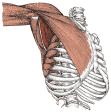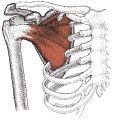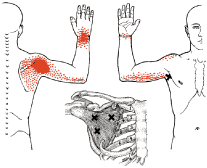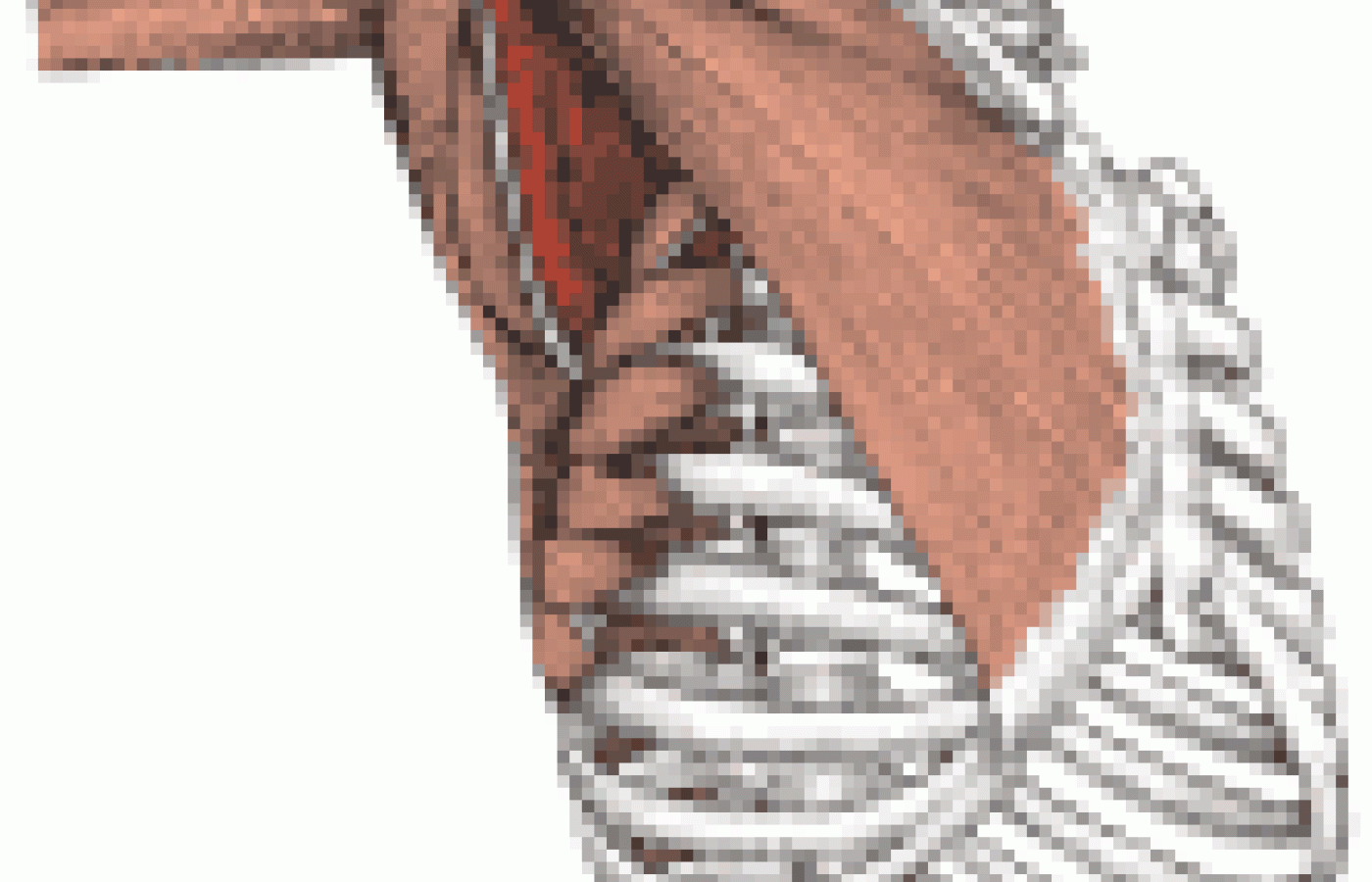Recent laws in New Jersey and California represent a disturbing trend that will negatively impact a practice’s ability to collect monies from patients, as well as expose them to significant penalties if the practice does not follow the mandatory guidelines to a T. Please be aware that a similar law may be coming to your state. The time to act is before the law is passed.
Shoulder Muscle Dysfunction and the Golf Swing: Important Treatment and Educational Considerations
The major medical/chiropractic focus among golfers is the low back. This makes sense, as low back injury and pain are common maladies suffered by golfers.1 Among amateur players, the low back is the most common site of injury, followed by the left wrist and left shoulder. Among professionals, injuries to the low back and left wrist are equally common, followed by injury to the left shoulder.2 Structures related to the cervicothoracic spine are equally at risk during the golf swing.
This article will discuss the basics of shoulder function and clinically focus on the subscapularis, a muscle that is often neglected and misunderstood.
Shoulder Function
While watching the golf swing, it's obvious that shoulder muscles are used to create a powerful swing. Not so obvious are the details of shoulder muscle activity during the swing.
Fortunately, a handful of electromyographic studies have given us a better understanding of shoulder muscle function during the golf swing.3,4,5 These studies demonstrate that rotator cuff muscles (particularly the subscapularis), the latissimus dorsi and pectoralis major are highly active during the golf swing.
Such findings have led to the conclusion that these muscles need to be exercised. In particular, Jobe, et al., state that, "to achieve greater distance it would seem that a golfer should concentrate on exercising the rotator cuff bilaterally as well as the latissimus dorsi and pectoralis major."3 Accordingly, most golf fitness books recommend that these muscles should be stretched and strengthened.7,8,9 While this approach is generally reasonable, there are specific situations during which these recommendations can be problematic for the unsuspecting patient/golfer.
The Subscapularis
The subscapularis is an intriguing muscle, primarily because it cannot be readily visualized or palpated (see Figure I).

The average person who has not studied anatomy would not expect that a rather large muscle could so easily take up residency beneath the "shoulder blades." We use the term "rather large" because the thickness and overall size of the subscapularis resembles that of the deltoid group10 (see Figure II).

The primary function of the subscapularis is internal rotation of the humerus. Several muscles act synergistically with the subscapularis, including the teres major, pectoralis major and latissimus dorsi. The subscapularis can also flex, extend, adduct, or abduct the glenohumeral joint depending on the position of the arm.10 Upper and lower subscapular nerves (C5, C6) that branch off the posterior cord of the brachial plexus innervate the subscapularis.
Travell and Simons are responsible for elucidating pain referral patterns from myofascial trigger points. In doing so, they made clinicians aware of novel sources of muscle pain that can masquerade as joint pain. The subscapularis muscle is an excellent example of this phenomenon. Figure III illustrates the pain referral patterns from subscapularis trigger points. The main referral zone is solid gray, while the spillover zone is stippled. Notice that the main pain zone is the posterior glenohumeral joint, with an additional area of striking pain around the wrist.

It is not uncommon to treat patients with these symptoms with injections, medications, and perhaps even surgery to correct the "problem" in the shoulder or wrist joints. This approach reveals a common error in the diagnosis and treatment of musculoskeletal problems: many docs and physical therapists just treat the site of pain. For obvious reasons, this approach should be avoided.
In the case of the golfer, we should have great concerns if subscapulais dysfunction is present. Whenever a golfer swings a club, significant activity is generated in the subscapularis on both sides3,4 that will aggravate any muscle tightness or trigger points within this muscle. In all likelihood, shoulder and wrist pain will continue to get worse, perhaps leading to a more severe injury of the subscapularis. Additionally and/or alternatively, a golfer with shoulder pain may believe that all he/she needs to do is strengthen the shoulder muscles. Golf fitness books will typically have the individual perform several exercises including internal rotation movements, with either weights or rubber tubing, that directly engage the subscapularis- the exact muscle that should not be challenged.
The Functional Approach
In treating musculoskeletal pain syndromes, it is important to remember that most of the time we are dealing with a functional disturbance/dysfunction of the locomotor system, not a patho-anatomic process. The locomotor system informs us of dysfunction by way of pain and tension.
Pain is perceived via nociceptor input; tension manifests in the form of tight muscles, dysfunctional joints and various soft reactions, such as painful thickening of skin, fascia and muscle. Our job is to ascertain the pattern of dysfunction and provide appropriate treatment. This process is easier when we understand that human beings are affected by stereotypical patterns of muscle imbalances that often occur in predictable kinetic chain reactions.
Muscle Imbalances
Humans seem prone to develop stereotypical patterns of muscle imbalance, such that some tend to become facilitated, which can act to reciprocally inhibit antagonist groups of muscles11,12 (see Table I). Imbalances develop, in part, from insufficient movement and lack of variety of movement (which characterizes the lifestyle of most people in our modern society) and due to overstrain and the maintenance of constrained postures.11,12,13 Even elite athletes who are quite mobile can develop the same imbalances.14,15 Research suggests that muscle imbalances begin during adolescence.16

In Table I, you can see that the subscapularis and pectoralis major tend to become facilitated or hypertonic, while antagonistic muscles (such as the infraspinatus, teres minor and rhomboids) tend to become reciprocally inhibited or hypotonic. You should already begin to wonder how this pattern might influence normal shoulder movements and special motions, such as the golf swing, that result in significant activation of the subscapularis. Should we strengthen the subscapularis merely because it is involved in generating power in the golf swing? What if the muscle is hypertonic or has active trigger points? These questions are not typically addressed during the treatment of golfers or when exercises are recommended. It is not uncommon for golfers with shoulder pain to exercises that strengthen the subscapularis and stretch out posterior shoulder muscles, including the infraspinatus, teres minor and rhomboids. If a patient's pain derives from subscapularis dysfunction, these exercises are the exact opposite of what should be done.
As suggested by the pain referral pattern illustrated in Figure I, any patient with shoulder pain should be examined for trigger points in the subscapularis. In examining the subscapularis, patient relaxation is paramount. Having the patient lie prone with the arms hanging off the table facilitates palpation of this hidden muscle. The doctor faces the patient from the side and places their cephalad hand on the superior aspect of the scapula. The caudal hand reaches into the axilla, with the palmar aspects of the fingers facing the deep surface of the scapula. Once past the posterior axillary fold, and deep into the axilla, the doctor, presses against the ventral surface of the scapula and tells the patient to internally rotate the arm. The firm round belly of the subscapularis will contract under the fingers of the doctor and the patient will experience severe pain if a trigger point is present.
Local trigger point ischemic compression is very effective, although often quite uncomfortable. Characteristic referred pain will be elicited, signaling that the correct muscle is being treated. Often this procedure is all that is needed. However, performing postisometric relaxation (PIR) may also be required to reduce more thoroughly the hypertonicity or trigger point.
You may use PNF patterns to inhibit the subscapularis. In this case, use a PNF pattern to eccentrically contract the antagonists of the subscapularis, which results in the facilitation of the external rotators and the reciprocal inhibition of the hypertonic subscapularis.
A dysfunctional subscapularis muscle is often one problem amidst a chain reaction. "Chain reaction" describes a pattern of locomotor dysfunction. Lewit and Kolar have published the most recent papers that describe chain reactions within the locomotor system.11,12,17
Chain Reactions
Chain reactions occur within groups of muscles that functionally work together to perform specific locomotor tasks, such as prehension, gait, maintenance of body statics and respiration. We will briefly examine the prehensile movement as it involves the subscapularis. Prehension involves grasping for an object that is in front of the body. Prehension occurs during eating, i.e., we reach out for food and bring it back to our mouth.
The first component of prehension is the reaching out phase to grasp an object. This phase predominantly utilizes upper extremity extensor muscles and external rotators of the humerus (the extensor-supinator-external rotator circuit). The second component of prehension involves grasping the object and bringing it toward the body for inspection, or consumption in the case of eating (the flexor-pronator-internal rotator circuit). This phase utilizes predominantly the flexor group of the hand and forearm to grasp the object. Then the upper extremity flexors and internal rotators of the humerus, i.e., subscapularis, are engaged to bring the object toward the body. Simultaneously, we engage our deep neck flexors, scalenes and SCM to flex our head forward to examine the object. The golf swing preferentially activates the flexor-pronator-internal rotator circuit. In a right-handed golfer, this occurs concentrically on the right side and eccentrically on the left.
Coincidentally, the flexor-pronator-internal rotator circuit typically becomes overactive due to overuse or injury, while the extensor-supinator-external rotator circuit responds with inhibition. If the subscapularis muscle is overactive and painful, assess other muscles associated with its functional chain for tightness. This includes the pectoralis major, scalenes and SCM, and also the wrist and finger flexors and forearm pronators.11,12 Related joints should also be assessed, including the wrist articulations, elbow, glenohumeral, craniocervical and cervicothoracic junction, as well as the upper ribs.11,12 Additionally, it should be mentioned that the pectoralis major and SCM might be involved in a pattern of muscle imbalance referred to as upper crossed syndrome (see Table II), which adds another dimension to the prehension chain reaction. Cervicothoracic stability is compromised when this pattern of muscle imbalance is present.18

Summary
In the clinical setting, it is not uncommon for a golfer/patient to present with the pattern of shoulder and wrist pain illustrated in Figure III. Unknowingly, this patient made an attempt at self care involving rotator cuff exercises focusing on internal rotation exercise with dumbbells to strengthen the subscapularis, and stretching exercises for the posterior shoulder muscles where the primary pain complaint is felt. By the time the patient reaches your office, he/she may even be considering surgery or cortisone injections.
Begin your functional examination at the subscapularis due to the classic pain referral pattern. Treat the subscapularis, then assess/treat additional muscles in the chain reaction, including the pectoralis major and upper trapezius. Proceed to adjust the craniocervical and cervicothoracic regions. At some point along this process, explain to your patient that he/she has been exacerbating their condition by doing inappropriate exercises.
The patient should now be educated about the rehabilitation process, involving home exercises that inhibit the hypertonic muscles and facilitate the reciprocally inhibited muscles. The patient should be shown how to: 1) stretch the subscapularis and facilitate the rhomboids; 2) stretch the pectoralis major and facilitate the serratus anterior; and 3) stretch the upper trapezius and facilitate the middle and lower trapezius. These exercises will enhance cervicothoracic and shoulder stability, which is required to safely swing a golf club and generate 100 miles per hour of club head speed at ball impact.
(Note: Figures 1, 2 and 3 available from: MediClip Manual Medicine I, 1997, Williams & Wilkens, a Waverly Company.)
References
- Seaman DR. Back pain in golfers: etiology and prevention. J Sports Chiro Rehab 1998;12(2):45-54.
- McCaroll JR. The frequency of golf injuries. Clin Sports Med 1996; 15:1-7.
- Jobe FW, Moynes DR, Antonelli DJ. Rotator cuff function during a golf swing. Am J Sports Med 1986;14(5):388-92.
- Jobe FW, Perry J, Pink M. Electromyographic shoulder activity in men and women professional golfers. Am J Sports Med. 1989;17(6):782-7.
- Pink M, Jobe FW, Perry J. Electromyographic analysis of the shoulder during the golf swing. Am J Sports Med 1990;18(2):137-40.
- Kao JT, Pink M, Jobe FW, Perry J. Electromyographic analysis of the scapular muscles during a golf swing. Am J Sports Med 1995;23(1):19-23.
- Carrido J. The Fitness Approach to Power Golf. New York: Perigee Books 1997.
- Jobe FW, Yokum LA, Mottram RE, Pink MM. Exercise Guide to Better Golf. Champaign, IL: Human Kinetics, 1994.
- Wolkodoff N. Physical Golf. Greenwood, CO: Kickpoint Press, 1997.
- Smith LK, Weiss EL, Lehmkuhl LD. Brunnstrom's Clinical Kinesiology. Philadelphia: FA Davis, 1996, p.246.
- Lewit K. Manipulative Therapy in Rehabilitation of the Locomotor System, 2nd ed. Boston: Butterworth-Heinemann, 1991.
- Lewit K. Chain reactions in the locomotor system in the light of co-activation patterns based on developmental neurology. J Ortho Med 1999;21:52-57.
- Janda V. Muscles, central nervous motor regulation and back problems. In: Korr IM (Ed). The Neurobiologic Mechanisms in Manipulative Therapy. New York: Plenum Press, 1978, 27-41.
- Schmid H, Spring H. Muscular imbalance in skiers. Manual Medicine 1985;2:23-26.
- Sommer HM. Patellar chondropathy and apicitis, and muscle imbalances of the lower extremities in competitive sports. Sports Medicine 1988; 5:386-394.
- Mackova J, Janda V, Macek M, Rutenfranz J, Radvansy J. Impaired muscle function in children and adolescents. J Manual Medicine 1989; 4:157-160.
- Lewit K, Kolar P. Chain reactions related to the cervical spine. In: Murphy DR (Ed). Conservative Management of Cervical Spine Syndromes. New York: McGraw Hill, 1999: 515-530.
- Murphy DR. Conservative Management of Cervical Syndromes. New York: McGraw-Hill, 1999.



